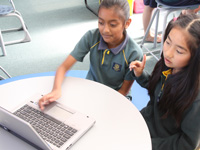

<p><img class=" alignright size-full wp-image-351" style="margin: 5px; float: right;" src="http://schoolnewsnz.fastrackdev.com/wp-content/uploads/2012/05/Education_-_My_Learning.jpg" alt="Education - My Learning" width="200" height="150" />Have you attended conferences, read articles and listened to experts speak about the way in which teachers and schools are not catering for the 21st century?</p>
<p> <!--more--> </p>
<p>How we are stuck teaching in a 19th century paradigm? How students are not well prepared for the ever-changing world they will encounter when they leave school?</p>
<p>We have all heard this numerous times, but how do we cater for the needs of a 21st century student effectively? One teacher believes she has the answer, in the form of a new pedagogy she has developed, called My-learning: an innovative pedagogical approach that combines self-directed learning, formative assessment, eLearning strategies as well as personalisation and individualisation of learning.</p>
<p>The idea behind the name &#8220;My-learning&#8221; comes from the children learning MY way, at MY pace, MY level and at a time that suits ME.</p>
<p>Learning at MY pace and a time that suits ME</p>
<p>Walk into a My-learning classroom and you will notice that there are some children doing maths and some English. Some will be talking in groups and some tucked away working individually. Some will be on laptops, others writing in their book. The self-directed nature of the programme means that students in a My-Learning classroom plan their time using a diary and a task list which they must complete within the requisite time frame of one week. This list will consist of individual and collaborative tasks, eLearning and more traditional tasks, tasks to cater for individual abilities and learning styles, and tasks covering a variety of curriculum areas. Children plan these tasks around pre-organised &#8216;meetings&#8217; that may be for the whole class or for groups of students based on ability or interest. This system allows for flexibility, autonomy and ownership which is something students in a My-learning classroom really value.</p>
<p>Learning in a My-learning classroom is tailored to &#8216;fit&#8217; students&#8217; needs. Conferencing is key to this and the teacher has a conference with each child individually at least once or twice a week. This may be at the child&#8217;s or teacher&#8217;s instigation and is made possible by the flexible, self-directed nature of the programme. Feedback is also given to students by their peers through the school&#8217;s online learning community as well as in the classroom. Students use peer feedback, teacher feedback and their own reflections to assess themselves formally and informally in an open and honest manner.</p>
<p>The teacher will also individualise the learning as much as possible. Children have individual writing and maths goals they work to achieve. They are constantly grouped and re-grouped according to strengths and weaknesses in their learning. There are optional meetings children can attend if they need or want to learn something and the teacher will only organise a whole class meeting if the whole class needs to learn a concept. These optional meetings may be at the teacher&#8217;s or the student&#8217;s instigation and children are sufficiently aware of their learning that they will attend such meetings willingly and on their own accord. The teacher&#8217;s planning is very carefully constructed so that every minute of the school day is focussed and productive for the children.</p>
<p>The formative assessment aspect of My-learning is key to moving children towards being actively engaged in their own learning. They have been taught to have ownership over their own learning and are encouraged to personalise their learning. Students will routinely teach and learn off other children. They will create extra work for themselves in order to work on an area that is a goal for them. You are also likely to witness children going to TED talks or Kahn Academy researching something they are curious about in their own time.</p>
<p>The style of learning can also be tailored to &#8216;fit&#8217; the child. Children have choice over whom, if anyone, they work with. They are able to talk about their learning, get help from others and bounce ideas around with their peers whenever they like throughout the day. They frequently get choice over the medium they will use to complete a task based on their learning style.</p>
<p>Students also value the modern learning environment in which they operate as this allows the flexibility to cater for different learning styles and needs.</p>
<p>Emma Winder has been teaching using the My-learning system she developed at Willow Park School on Auckland&#8217;s North Shore for three years now and is confident that the students are engaged, motivated, taking responsibility for their learning and progressing academically. For more information on this system as well as resources to make it happen, head to Emma&#8217;s blog: http://my-learning.me</p>

NZEI Te Riu Roa is considering legal action against the government for the disestablishment of…
NZQA is implementing AI-marking for all Year 10 written assessments from this year onwards, following…
Teaching personal financial responsibility isn't enough. Children should be taught broader economic context, argue New…
When students can't hear the teacher, they can't learn properly. Sound quality matters in education…
The Garden City is rich with learning opportunities, no matter what subject or part of…
Teaching Council of Aotearoa launch school leaders’ stories project with Unteach Racism to challenge institutional…
This website uses cookies.